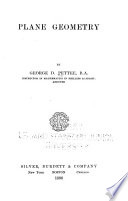 | George Albert Wentworth - 1883 - 536 pages
...co-ordinates of A are x=7, у = — 4 ; the co-ordinates of B are x = 4, у = — 7. Since the square on the hypotenuse of a right triangle equals the sum of the squares on the other two sides, inspection of the diagram shows that (if r be the radius of the circle), Hence,... | |
 | Charles Ambrose Van Velzer, George Clinton Shutts - Geometry - 1894 - 416 pages
...explained in Art. 260. Using this language, the Pythagorean proposition is often stated as follows: The square of the hypotenuse of a right triangle equals the sum of the squares of the other two sides. The proposition is often put in the form of an equation, thus: AC* = A Bz + B... | |
 | George D. Pettee - Geometry, Modern - 1896 - 272 pages
...of conseq.H I as any ant, is to its conseq. J PROPOSITION XI THE PYTHAGOREAN THEOREM 258. Theorem. The square of the hypotenuse of a right triangle equals the sum of the squares of the legs. First Method Appl. Prove AC * = AB * + B(f Cons. Draw -L BD Dem. AB = AC x AD .. , t . .... | |
 | Alvord D. Robinson - Arithmetic - 1902 - 572 pages
...whose faces are triangular. Pythagorean theorem. The one first proved by Pythagoras, that the square on the hypotenuse of a right triangle equals the sum of the squares on the other two sides. Quadrilateral. A figure having four sides. Quantity. Answer to the query "How... | |
 | Fletcher Durell - Geometry, Solid - 1904 - 232 pages
...the areas of similar polygons are as the squares of their homologous sides, and that the square on the hypotenuse of a right triangle equals the sum of the squares on the other two sides. The latter is called the Pythagorean theorem. They also discovered how to construct... | |
 | Fletcher Durell - Geometry, Plane - 1904 - 382 pages
...the areas of similar polygons are as the squares of their homologous sides, and that the square on the hypotenuse of a right triangle equals the sum of the squares on the other two sides. The latter is called the Pythagorean theorem. They also discovered how to construct... | |
 | Fletcher Durell - Geometry - 1911 - 553 pages
...the areas of similar polygons are as the squares of their homologous sides, and that the square on the hypotenuse of a right triangle equals the sum of the squares on the other two sides. The latter is called the Pythagorean theorem. They also discovered how to construct... | |
 | George Clinton Shutts - 1905 - 260 pages
...the given line, it must be interpreted as in §329. (a) The Pythagorean proposition is often stated: The square of the hypotenuse of a right triangle equals the sum of the squares of the other two sides. It is frequently expressed as an algebraic equation, thus: A~C 2 = A~B 2 +"B~C... | |
 | Education - 1914 - 220 pages
...rectangles and triangles as shown in Fig. 79. Compare the remainders. This proves that — The square on the hypotenuse of a right triangle equals the sum of the squares on the other two sides. Arrange the figures as shown in fig. 80, and paste them in your book. The dotted... | |
 | Samuel Hamilton - Arithmetic - 1907 - 422 pages
...on the other two sides. Since they are equal, the truth of the proposition is evident. The square on the hypotenuse of a right triangle equals the sum of the squares described on the other two sides. Written Work l. Find the hypotenuse of this right triangle. Hypotenuse*... | |
| |